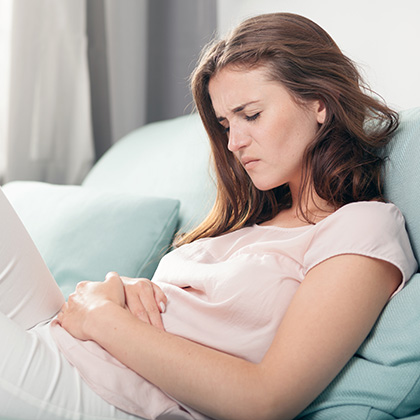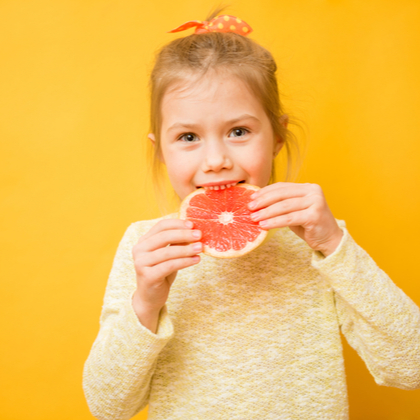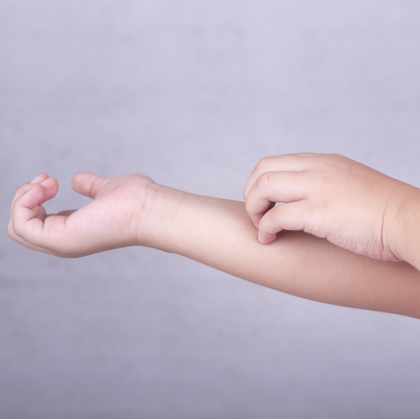
Constipation may be a common problem among adults but it’s very common in children too. According to the National Institute for Health and Care Excellence (NICE), 30 per cent of UK children aged between four and 11 will have constipation lasting less than six months, while five per cent will have longer-lasting constipation – with the most common age for constipation being around two to three years of age (typically the age for toilet training) (i).
Constipation for most children means passing hard stools less often than normal and with difficulty (straining and pain, for instance). The NHS says a child may be constipated if they don’t have a bowel motion at least three times a week, if their stool is large and hard, or if it looks like little pellets (think rabbit droppings) (ii).
But what is normal exactly? NICE says that, in the UK, normal stool frequency in children ranges from an average of four a day during a baby’s first week of life to two a day by the time they get to their first birthday. Then by the time they’re four years old they usually settle into the normal adult pattern of between three a day and three per week (iii).
However, it’s also a good idea to remember that normal can vary greatly from one child to another, and it’s not the number of times a child has a bowel movement that’s important but that the stools themselves are soft and easy to pass. Parents usually become aware of what’s normal for their child, including how different foods can affect their stools and bowel habits. And often it’s a change in what’s normal for a child that suggests a problem.
How digestion works
When your child eats, the food is chewed, swallowed and makes its way to the stomach. Stomach acids break down the food further until it’s mostly liquid, then the liquid passes through the small intestine (or small bowel). This is where the nutrients in the food are absorbed.
The liquid that remains is waste material that travels along the digestive system to the large intestine (or large bowel), where some of the water from the liquid is absorbed as it passes through. Finally, the waste – the stool or faeces – reaches the rectum and is eventually passed out of the body. However, the longer it stays in the large intestine – and the more waste builds up behind it – the more water is absorbed from the stool, making it harder and more difficult to pass.
What are the symptoms?
Besides the obvious symptoms of passing hard stools less often than normal, children and babies with constipation may also experience one or more of the following:
-
A small amount of blood in their nappy or on the toilet paper caused by a tear in their back passage (anal fissure)
-
Abdominal pain
-
Loss of appetite
-
Nausea
-
General feeling of being unwell
-
Irritability and mood changes
-
Restlessness, fidgeting
In children who have already been potty trained, soiled underwear can also be a sign of severe constipation called impaction. This is when the rectum – the lowest part of the bowel – becomes blocked by a large amount of hard stool.
Impaction is most common in children aged two to four years, though those who are older or younger can also be affected (iv). According to patient.co.uk, parents often mistake the soiling for diarrhoea, when it is actually very soft faeces or faecal-stained mucus that leaks out of the anus when a child has an impacted stool (iv).
What causes it?
In most cases there’s no underlying physical reason for constipation in children – this is known as idiopathic constipation (idiopathic means of unknown cause). However, while it may not have any underlying physical cause there are several things that may contribute to idiopathic constipation or make it worse. These include the following:
Diet
A child may develop constipation if they don’t have enough fibre in their diet, as a lack of fibre may make their stools harder, drier and more difficult to pass. According to the BDA (The Association of UK Dietitians), the amount of fibre children should eat is:
-
15g a day for children aged two to five years
-
20g a day for children aged five to 11 years
-
25g a day for children aged 11 to 16 years
-
30g a day for teenagers aged 16 - 18 years (this is also the amount recommended for adults)
Like adults, however, most children don’t eat enough fibre. Overall, says BDA experts, children of primary school age should try to eat 5g more a day, while those in secondary school should try to eat 9g more (v).
Examples of foods that are rich in fibre include fruit, vegetables, high-fibre bread, baked beans, brown rice and wholegrain breakfast cereals (however, you should avoid giving wholegrain starchy foods to children younger than two years of age).
Water intake
Children need to drink plenty of water to keep their digestive systems healthy, with babies who are bottle or breast fed getting the water they need from milk. Meanwhile NICE suggests the following guidelines for daily water intake (including water contained in drinks and in food), though children who are physically active, exposed to hot environments or obese will need more (vi):
-
Children aged one to three years: 1300ml (900ml from drinks)
-
Children aged four to eight years: 1700ml (1200ml from drinks)
-
Boys aged nine to 13 years: 2400ml (1800ml from drinks)
-
Girls aged nine to 13 years: 2100ml (1600ml from drinks)
-
Male teens aged 14 - 18 years: 3300ml (2600ml from drinks)
-
Female teens aged 14 - 18 years: 2300ml (1800ml from drinks)
Stool withholding
This is when a child avoids or puts off emptying their bowels. This can lead to a build-up of waste in their large intestine, and when they finally do have a bowel motion it may be difficult and even painful. Several things may make this behaviour more likely, including:
-
Fear or anxiety about using the toilet, at home and/or outside the home (at school, for instance).
-
Having had a previous episode of constipation, where passing a stool was difficult or painful.
-
Having an anal fissure, which can make it painful to pass stools.
Emotional issues
Some children may develop constipation when they become upset – such as when they start school or if there’s a change in their routine. Some also find potty training stressful, which may explain why constipation is most common at the potty-training stage.
Children may also be more susceptible to constipation if it runs in the family.
Could an underlying illness be to blame?
In a very small number of cases constipation in children is caused by a medical problem. Some of the conditions that can cause constipation include certain neurological conditions (Down’s syndrome and autism, for example), an underactive thyroid gland, cystic fibrosis, coeliac disease and some rare illnesses that affect how the bowel develops such as Hirschsprung’s disease. Certain medicines may also cause constipation as a side effect.
How to prevent constipation in children
While there often isn’t any obvious reason why children have constipation, there’s lots you can do to make it less likely.
Give them plenty to drink
Drinking lots of fluids can help keep your child’s bowels healthy because it can make their stools softer and easier to pass. Try to make sure your child drinks the amount of fluids they need per day for their age (see above). Water is the ideal drink for children, but you could also give them milk or well-diluted fruit juice or squash. Drinks you should avoid giving your children include anything with caffeine, such as tea, coffee and cola, as well as sugary fizzy drinks. Meanwhile, babies who are bottle fed can have extra water between some of their feeds to help prevent constipation.
Make sure their diet is healthy
A healthy balanced diet that includes plenty of fruit and vegetables a day should give your child the fibre their digestive system needs to prevent constipation, as well as some of the fluids they need. Fruit and vegetables also contain a wide range of vitamins and minerals, so try to introduce a variety of different foods in their diet from an early age. If your child’s a fussy eater try making fruit more appealing by cutting it up into little chunks – apples and pears are particularly good for constipation – and add extra vegetables that have been blended in a food processor to soups, sauces and mashed potatoes.
Keep them active
Running around and playing is good for children's digestive systems because it helps move food and food waste through the bowel quickly and easily. Try to make sure your child doesn’t sit for long periods of time and encourage them to stand up and move around frequently. They also need plenty of energetic exercise during their day, such as riding a bike, skipping, jumping on a trampoline, swimming, climbing, dancing and playing energetic games such as hide and seek.
Establish a regular potty or toilet routine
Young children need to have a regular toilet routine where they have plenty of time to sit on the toilet or potty at the same times each day, ideally about half an hour after eating, before going to school and before going to bed. If they’ve started to sit on the toilet, try using a box or step and a training seat to make them more comfortable if necessary (ideally their feet should be flat on the floor with their knees higher than their hips).
Offer reassurance
If you think your child is anxious about using the toilet at school, try to reassure them that going to the toilet is normal and natural and not something to be afraid or ashamed of. Stay as calm as possible and try not to make a big issue about it – if you let the problem get to you, your child may sense it and become even more anxious. Your health visitor can also give you advice that may help your child feel less stressed about going to the toilet.
Treatments for children’s constipation
If you think your child may be constipated, take them to see their GP, as treatments for constipation in children aren’t recommended unless prescribed by a doctor. If they have constipation not related to any underlying medical condition that has lasted for more than a few days, it will usually be treated with medicines called laxatives. Their GP will prescribe the right type and strength for your child’s age and the severity of their constipation.
Laxatives for children are usually in powder or liquid form, some of which you can add to water and squash to make them taste nice. There are several different types of laxatives available, but the ones usually given to children are osmotic and stimulant laxatives.
Osmotic laxatives
These work by drawing water from the body into the bowel to make stools softer and easier to pass. However, they can take two or three days to work. Examples include lactulose and polyethylene glycol.
Stimulant laxatives
These work faster than osmotic laxatives (within six to 12 hours) and are so called because they stimulate the bowel to push out stools. There are several different types, including bisacodyl, senna and sodium picosulfate. Your child’s GP may prescribe both types of laxatives if osmotic laxatives alone aren’t effective.
Once your child’s bowels are back to normal and they no longer have constipation, your GP may advise you to keep giving them laxatives for several more weeks. Even though your child may seem normal again, it’s important not to stop their laxatives suddenly – you should gradually lower their dose instead. That’s because if they stop taking laxatives abruptly, it could make them constipated again quite quickly.
Meanwhile, if your child has constipation with impaction, they may need higher doses of laxatives, and they may have to take them for much longer too.
Other ways to support your child
A healthy lifestyle can help reduce a child’s risk of developing constipation. Certain nutritional supplements may also be useful, including:
Live bacteria
There is some evidence to suggest live bacteria supplements may have positive effects on the symptoms of constipation in children, with one small-scale study finding a mixture of different live bacteria increases the frequency of bowel motions in children aged 4 - 16 with constipation (vii). Look for products that contain live bacteria such as Lactobacillus acidophilus and Bifidobacterium.
Soluble fibre
Natural soluble fibre supplements – such as those that contain an active ingredient called fructo-oligosaccharides (FOS) – can also help boost children’s digestive systems by helping to maintain normal intestinal health. These are usually suitable for children aged four years and older.
Multivitamin and mineral
Make sure your child is getting all the major nutrients their growing body needs with a children’s multivitamin and mineral supplement. Make sure you give them a supplement that’s formulated for children, and if they don’t like swallowing tablets look for a chewable product designed to be palatable for children (make sure it’s sugar free to help protect their teeth) or one that dissolves in water to make a fizzy drink.
Elderberry
It’s also a good idea to make sure your child’s immune system is supported whenever they are feeling poorly. Try a tasty liquid formulation suitable for children that can be taken by the spoonful or diluted in drinks containing immune-boosting ingredients such as elderberry, blackcurrant and rosehips.
When sourcing nutritional supplements for children it’s a good idea to use a reputable company that can give you advice about the products that may be suitable for them. Always ask if you’re not sure whether you should give your child any particular supplements.
References:
-
Available online: https://cks.nice.org.uk/constipation-in-children#!backgroundSub:2
-
Available online: https://www.nhs.uk/conditions/pregnancy-and-baby/constipation-and-soiling
-
Available online: https://cks.nice.org.uk/constipation-in-children#!backgroundSub
-
Available online: https://patient.info/digestive-health/constipation/constipation-in-children
-
Available online: https://www.bda.uk.com/foodfacts/fibre_fact_sheet_poster
-
Available online: https://cks.nice.org.uk/constipation-in-children#!scenario
-
Bekkali. N.L., et al. The role of a probiotics mixture in the treatment of childhood constipation: a pilot study. Nutr J. (2007 Aug). 4;6:17. Available online: https://www.ncbi.nlm.nih.gov/pubmed/17683583
Related Posts
Disclaimer: The information presented by Nature's Best is for informational purposes only. It is based on scientific studies (human, animal, or in vitro), clinical experience, or traditional usage as cited in each article. The results reported may not necessarily occur in all individuals. Self-treatment is not recommended for life-threatening conditions that require medical treatment under a doctor's care. For many of the conditions discussed, treatment with prescription or over the counter medication is also available. Consult your doctor, practitioner, and/or pharmacist for any health problem and before using any supplements or before making any changes in prescribed medications.

Christine
Christine Morgan has been a freelance health and wellbeing journalist for almost 20 years, having written for numerous publications including the Daily Mirror, S Magazine, Top Sante, Healthy, Woman & Home, Zest, Allergy, Healthy Times and Pregnancy & Birth; she has also edited several titles such as Women’ Health, Shine’s Real Health & Beauty and All About Health.
View More



